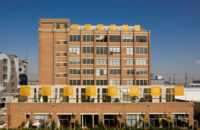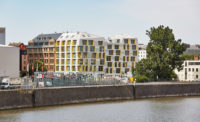Mount Rainier, Maryland
Artists have long served as conduits for change in marginalized neighborhoods, braving difficult environments in exchange for low rent and often unwittingly paving the way for mainstream inhabitants. In the case of the Mount Rainier Artist Lofts, creative people were lured quite intentionally as pioneers for change in hopes of turning around the fate for Mount Rainier, Maryland, a small, deteriorating street-car suburb just a block from the border with the District of Columbia.
With the goal of reinventing the small, historic residential neighborhood, the Prince Georges County Redevelopment Authority, community activists, and local nonprofit groups combined forces to create the Gateway Arts District and develop a master plan for a 2-mile-long stretch of Rhode Island Avenue Extended, or Route 1, the area’s commercial corridor. Artspace, a Minneapolis-based nonprofit developer involved in the project, brought in Minneapolis-based HGA Architects and Engineers to help create, on the former site of three derelict businesses, a mixed-use building that would provide affordable live/work spaces for artists and their families.
While Mount Rainier is on the National Register of Historic Places, the building would serve a forward-thinking community. “The artists, on one hand, wanted a funky, contemporary building,” says Bill Madden, AIA, project architect and manager, “while the Design Review Board and the Mount Rainier residents requested a more contextual architecture emulating the modestly scaled historic styles of the neighborhood.” During initial planning phases, the design team held public forums, garnering community input about the scale, design, and materials for the project. Responding to the board’s requests, the architects incorporated Classical elements in the facade, such as a base and cornice, and used double-hung windows, proportioned to match those of surrounding buildings. However, they took liberal creative license with these features; for example, installing corrugated metal horizontally around windows to mimic louvered shutters and creating a metal-strip cornice.
In the early stages of the project, the size of the site was decreased, presenting the architects with another challenge: how to keep the scale of the building (whose structure is composed principally of precast concrete) down while maintaining the same number of units on a now smaller footprint. To do so, they set back the top floor and clad it in galvanized-metal siding, giving it the appearance of a line of boxcars, a nod to the main railroad spur that sits behind the site. In response to a tight construction budget ($8.3 million—about $110 a square foot for the 73,000-square-foot building), the architects concentrated their efforts on the exterior, leaving the residents to fit out the interiors. The discovery that quilting had been a regional tradition piqued the interest of one of the designers, a quilter herself, who created imagery that morphed into a patchwork look for the facades, incorporating a variety of brick and corrugated-metal-siding colors, including clear galvanized, red, orange, and gray.
The wedgelike site led to an arrow-shaped building, which lends itself to a collection of unique units, with 18 different configurations for the 44 apartments. Interiors are simple to an extreme, boasting a preponderance of drywall, red vinyl flooring in the public halls, and exposed pipes and ducts and plywood-decked lofts in the double-height apartments. Ornamentation and personalization has been left up to the residents, who have adorned public spaces with their sculptures and collages, and inside the units have painted murals, applied large photographs to stair risers, or even installed soundproof recording studios.
HGA’s other projects for the Arts District—including residential buildings and a museum and cultural center—are currently on hold, and the area still has the feel of being in the early stages of emergence. However, on a smaller scale, at least, Mount Rainier Artist Lofts (which is almost always fully occupied) is fostering change as it has evolved into a tight-knit nexus for creative individuals who, enjoying subsidized rents as low as $555 for a studio apartment, are able to pursue their art.





